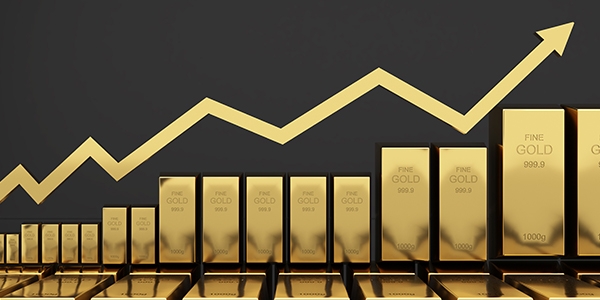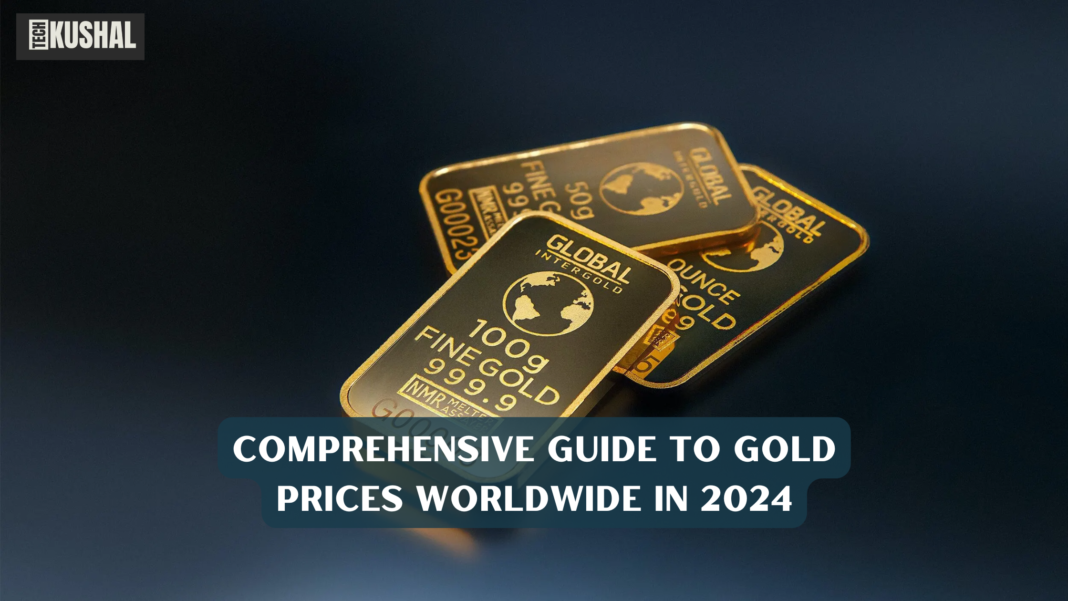
Comprehensive Guide to Gold Prices Worldwide, Gold has always held a significant place in the global financial market, acting as a hedge against inflation, currency fluctuations, and economic instability. As we navigate through 2024, the price of gold remains a critical focus for investors, economists, and governments alike. This article provides an in-depth analysis of the factors influencing gold prices this year, offering a detailed look at regional variations and future projections.
Read More: How to Track Daily Changes in Gold Rates 2024
Global Economic Uncertainty: A Major Driver of Gold Prices

The global economy in 2024 is marked by significant uncertainty. Geopolitical tensions, particularly in Eastern Europe and the Middle East, continue to fuel concerns about economic stability. These uncertainties have a direct impact on investor behavior, driving many to seek refuge in gold, which is traditionally seen as a safe haven during turbulent times.
The Russia-Ukraine conflict, which has persisted into 2024, has had a profound effect on energy prices, inflation, and investor confidence. As sanctions and counter-sanctions continue to affect global trade, gold has become an increasingly attractive asset for those looking to protect their wealth from potential market downturns.
Inflation: The Ongoing Catalyst for Gold Demand

Inflation rates have been a central theme in the global economic narrative throughout 2024. In many countries, inflation remains stubbornly high, despite aggressive monetary tightening by central banks. This persistent inflation has led to an increased demand for gold, as it is widely regarded as a reliable store of value in times of rising prices.
In the United States, for example, the Federal Reserve has continued its policy of raising interest rates to combat inflation. However, the impact on the broader economy has been mixed, with some sectors struggling under the pressure of higher borrowing costs. As a result, gold prices in the US have remained elevated, with investors seeking to hedge against both inflation and potential economic slowdowns.
Central Bank Policies and Interest Rates: A Delicate Balance

The relationship between interest rates and gold prices is complex and multifaceted. In 2024, central banks around the world are treading a fine line between controlling inflation and avoiding a recession. The decisions made by these institutions have a direct impact on gold prices, influencing both demand and supply.
In Europe, the European Central Bank (ECB) has adopted a cautious approach to interest rate hikes, balancing the need to curb inflation with the risk of stifling economic growth. This cautious stance has helped to maintain strong demand for gold in the Eurozone, where investors are wary of potential economic disruptions.
In Asia, central banks in countries like India and China have taken a more aggressive stance, raising interest rates to combat inflationary pressures. This has had a mixed impact on gold prices, with some investors moving towards gold as a safe haven, while others are drawn to higher-yielding assets.
Currency Fluctuations and Their Impact on Gold Prices

Currency fluctuations have a significant impact on gold prices, particularly in countries where the local currency is weak against the US dollar. In 2024, the strength of the dollar has been a key factor influencing gold prices worldwide.
For example, in emerging markets such as India and Brazil, the depreciation of local currencies against the dollar has made gold more expensive for domestic buyers. This has led to a decrease in consumer demand for gold jewelry in these markets, although investment demand remains strong.
Conversely, in countries with stronger currencies, such as Japan, gold has become relatively more affordable, boosting demand. The interplay between currency strength and gold prices is a crucial factor to consider when analyzing the global gold market in 2024.
Regional Variations in Gold Prices
United States
In the United States, gold prices have been heavily influenced by the Federal Reserve’s monetary policy. As interest rates continue to rise, the opportunity cost of holding gold (which does not yield interest) increases. However, ongoing concerns about inflation and economic stability have kept gold prices relatively high.
Europe
Europe presents a unique case in the global gold market. The region’s economic challenges, including the ongoing energy crisis and geopolitical tensions, have driven demand for gold as a safe haven. The ECB’s cautious approach to interest rate hikes has also played a role in maintaining strong gold prices across the continent.
Asia
Asia remains a major consumer of gold, with India and China leading the way. In India, gold prices are influenced by both global trends and domestic factors, such as the value of the rupee and seasonal demand during festivals. In China, gold is not only a popular investment but also a key component of the country’s cultural heritage, leading to sustained demand even in times of economic uncertainty.
Middle East
The Middle East is another critical region in the global gold market. Dubai, often referred to as the “City of Gold,” continues to be a major hub for gold trade. In 2024, gold prices in the Middle East have remained steady, supported by strong demand for jewelry and investment products. The region’s relative economic stability, coupled with its significant gold reserves, has helped to maintain a stable gold market.
Future Outlook for Gold Prices in 2024
Looking ahead, the future of gold prices in 2024 is likely to be shaped by a combination of factors, including inflation, central bank policies, and geopolitical developments. While it is difficult to predict with certainty, several trends are likely to play a key role in determining the direction of gold prices.
Inflationary Pressures
If inflation continues to remain high, demand for gold as a hedge against rising prices is likely to persist. This could lead to further increases in gold prices, particularly if central banks are unable to bring inflation under control.
Central Bank Policies
The actions of central banks will be closely watched by investors. If interest rates continue to rise, there could be downward pressure on gold prices, as higher yields on bonds and other fixed-income assets become more attractive. However, if central banks adopt a more dovish stance in response to economic slowdowns, gold prices could rise further.
Geopolitical Tensions
Geopolitical tensions will continue to be a significant factor influencing gold prices in 2024. Any escalation in conflicts, particularly in regions with significant economic or strategic importance, could lead to a spike in gold demand as investors seek to protect their wealth.
Conclusion
Gold prices in 2024 are being influenced by a complex web of factors, including global economic uncertainty, inflation, central bank policies, and currency fluctuations. While the future remains uncertain, gold’s role as a safe haven asset ensures that it will continue to be a key component of investment portfolios worldwide.
Investors, governments, and consumers will need to stay informed about these trends as they navigate the challenges and opportunities presented by the global gold market in 2024.
FAQs About Gold Prices Worldwide in 2024
1. What are the main factors influencing gold prices in 2024?
Gold prices in 2024 are influenced by several key factors, including global economic uncertainty, inflation, central bank policies, and currency fluctuations. Geopolitical tensions and investor sentiment also play significant roles in shaping the price of gold.
2. How does inflation impact gold prices?
Inflation typically increases the demand for gold, as the metal is seen as a hedge against rising prices. When inflation is high, investors tend to buy gold to protect their wealth from the eroding purchasing power of currency, driving up the price of gold.
3. How do central bank policies affect gold prices?
Central bank policies, particularly interest rate decisions, have a direct impact on gold prices. Higher interest rates can make bonds and other fixed-income assets more attractive, potentially reducing demand for gold. However, in times of economic uncertainty, gold can still retain its appeal even when interest rates rise.
4. Why do currency fluctuations impact gold prices?
Gold is typically priced in US dollars, so when the dollar strengthens, gold becomes more expensive for holders of other currencies, which can reduce demand. Conversely, when the dollar weakens, gold becomes more affordable internationally, often increasing demand.
5. How are gold prices different across regions?
Gold prices vary across regions due to factors such as local demand, currency strength, and economic conditions. For example, in the United States, gold prices are closely tied to Federal Reserve policies, while in Asia, cultural demand and local currency values play significant roles.
6. What is the outlook for gold prices in 2024?
The outlook for gold prices in 2024 depends on a combination of factors including the trajectory of inflation, central bank actions, and geopolitical developments. While the future is uncertain, gold is likely to remain a key investment for those seeking stability in volatile times.
7. How does geopolitical tension influence gold prices?
Geopolitical tensions can increase the demand for gold as investors seek safe-haven assets during times of uncertainty. Events such as conflicts, sanctions, or political instability can lead to higher gold prices as markets react to potential risks.
8. Why is gold considered a safe haven asset?
Gold is considered a safe haven because it tends to hold its value during times of economic or political instability. Unlike paper currency, which can be affected by inflation or devaluation, gold has intrinsic value and is widely accepted as a form of wealth preservation.
9. How do interest rates in different countries affect gold prices?
Interest rates impact gold prices by influencing the opportunity cost of holding non-yielding assets like gold. In countries where interest rates are rising, gold might become less attractive compared to bonds or savings accounts that offer interest. However, if the economic outlook is uncertain, gold can still be in demand.
10. Is gold still a good investment in 2024?
Gold continues to be a valuable investment in 2024, particularly for those looking to hedge against inflation, currency fluctuations, and economic uncertainty. While gold prices can fluctuate, its historical role as a store of value makes it an important part of a diversified investment portfolio.


